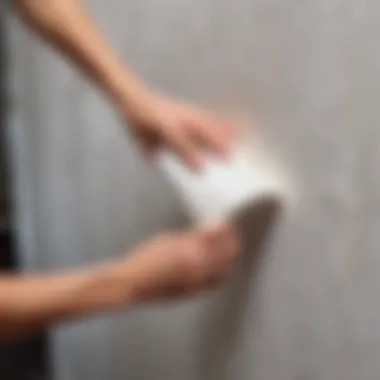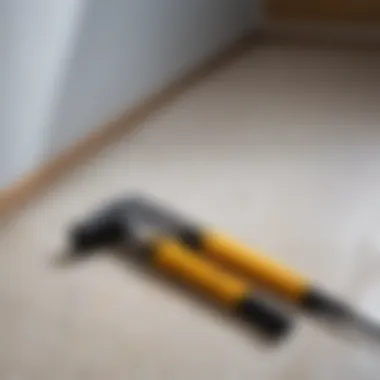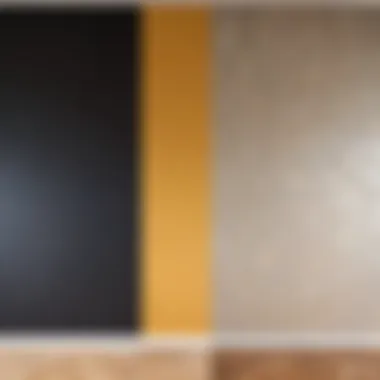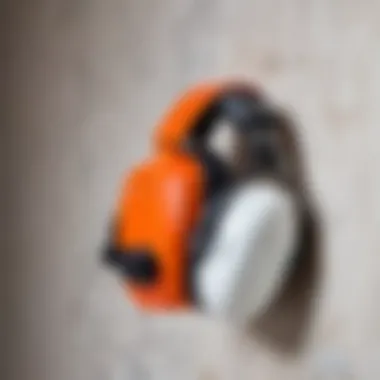Efficient Techniques for Vinyl Wallpaper Removal


Intro
Removing vinyl wallpaper can seem like a daunting task. Many homeowners and professionals find themselves overwhelmed by the thought of tackling this project. However, understanding the methods and materials that are best suited for this purpose can significantly simplify the process. This article explores efficient techniques that can aid in quickly removing vinyl wallpaper while preserving the condition of the wall beneath.
Vinyl wallpaper is often chosen for its durability and aesthetic appeal, but when it becomes outdated or damaged, removal is necessary. Knowing how to approach this task can save both time and effort. The methods discussed here not only emphasize speed and efficiency but also ensure that the underlying surface remains intact.
Проектирование и планирование
Before diving into the removal process, proper project planning is crucial. This phase involves assessing what needs to be done and preparing for the task ahead.
Как выбрать проект для DIY
Choosing the right project begins with evaluating the area where the wallpaper is located. Consider whether the removal is part of a larger renovation or a standalone task. Understand the type of wallpaper used in the area. Is it peelable or traditional vinyl? This knowledge is essential as it affects the technique required for removal.
Оценка времени и ресурсов
Establish a timeline for your project. Factors to consider include:
- Size of the area
- Type of wallpaper
- Your experience level
- Necessary materials and tools available
Preparing your tools ahead of time can help streamline the process and avoid interruptions.
Выбор материалов
Selecting the right materials can greatly impact the efficiency of removing vinyl wallpaper. Several products can aid in the removal process, such as:
- Wallpaper scraper or putty knife
- Wallpaper removal solution (commercial or homemade)
- Steamer
- Sponges and rags
- Plastic sheeting to protect floors
Типы материалов для различных проектов
Different projects may require different methods and materials. For example, if the wallpaper is glued directly to the wall, a steamer can provide necessary heat to loosen the adhesive. If on the other hand, the wallpaper is peelable, simpler methods may suffice.
Советы по покупке и экономии
When purchasing materials, look for discounts or buy in bulk if possible. Check local hardware stores and online resources. Consider tools that can be reused for future projects as an investment rather than a one-time expense.
"Proper planning and choosing the right materials can save you from unnecessary hassles during the wallpaper removal process."
By taking the time to plan the project carefully and selection appropriate materials, the task of removing vinyl wallpaper can be manageable and efficient.
Understanding Vinyl Wallpaper
Understanding vinyl wallpaper is crucial for navigating the removal process effectively. Many people attempt to take down wallpaper without appreciating its unique properties. This lack of understanding often leads to ineffective removal methods that can damage the underlying wall. By gaining insight into its composition, common types, and adhesive methods, one can approach the task with both confidence and efficiency.
Composition of Vinyl Wallpaper


Vinyl wallpaper is made primarily from polyvinyl chloride (PVC), a synthetic plastic polymer known for its durability and water-resistant properties. It typically consists of a printed paper back and a vinyl surface that can withstand moisture and make cleaning easier. The composition makes it a popular choice in homes and commercial spaces, especially in high-traffic areas or environments subject to spills. Knowing this helps in choosing the appropriate removal method, as certain solvents may react differently with PVC compared to traditional paper wallpapers.
Common Types of Vinyl Wallpaper
There are different types of vinyl wallpaper available, which can vary in texture and durability. Some common types include:
- Vinyl Coated Paper Wallpaper: This type has a paper backing with a vinyl coating. It is easier to remove but less durable than thicker types.
- Solid Vinyl Wallpaper: This version is fully made from vinyl, giving it a thicker, more substantial feel. It is more resistant to wear and moisture but can be more challenging to remove.
- Peel and Stick Vinyl Wallpaper: This modern type allows for easy application and removal without damaging the walls. This is ideal for renters or those looking to update their decor frequently.
Understanding these categories allows for better planning and expectation management as one prepares for removal.
Identifying Wallpaper Adhesive Types
Another critical aspect of vinyl wallpaper removal is recognizing the type of adhesive used. There are generally two kinds of adhesives:
- Strippable Adhesives: These allow the wallpaper to be removed in large sheets with minimal damage to the wall. This is common in modern installations.
- Permanent Adhesives: This type securely bonds the wallpaper to the wall. Removing wallpaper adhered this way requires more effort and often leads to more wall damage.
Identifying the adhesive type can save time and resources. A proper assessment enables one to select the most effective removal technique, avoiding unnecessary complications during the process.
Preparation for Removal
Preparation is a crucial aspect when it comes to removing vinyl wallpaper efficiently. Without proper planning, the process can become unnecessarily complicated, leading to potential damage to walls and a longer removal time. Taking the time to prepare can make all the difference, whether you are a DIY enthusiast or a professional.
One important element of preparation is assessing the condition of the wallpaper. This step helps to identify whether the wallpaper is in good shape, peeling, or already coming off. Depending on its condition, the method for removal might differ. For instance, if the wallpaper is well-adhered, using steam or a chemical solution may be more effective. Conversely, if it's already loose in places, a manual technique might suffice.
Additionally, gathering necessary tools and materials is a key part of preparation. Before starting the removal process, ensure that you have all the needed supplies readily available. Common tools include a wallpaper scraper, a utility knife, and a sponge or cloth for applying solutions. Having these tools on hand helps maintain momentum during the removal process.
Lastly, understanding safety precautions cannot be overlooked. Removing wallpaper often involves the use of chemicals or steam, which can pose hazards if not handled properly. It is essential to wear appropriate protective gear such as gloves and goggles. Also, ensuring there is adequate ventilation in the work area is crucial when using chemical solutions.
In summary, appropriate preparation not only streamlines the removal process but also minimizes the risk of damage and injury. Taking these steps ensures a smoother and more efficient experience.
Assessing the Condition of Wallpaper
Before diving into the removal process, it is critical to assess the condition of the wallpaper. This assessment involves a close inspection to determine how well the wallpaper is adhering to the wall surface. Look for any loose edges, bubbles, or signs of peeling. If the wallpaper is old and has begun to deteriorate, it might be easier to remove than newer wallpaper that is still firmly attached.
Understanding the condition allows you to choose the most suitable removal technique. For wallpapers that are tightly adhered, methods such as steam or chemical solutions may be necessary to loosen the adhesive effectively. In cases where the wallpaper is already partially removed or damaged, manual techniques might suffice, saving time and effort.
Gathering Necessary Tools and Materials
Having the right tools and materials is vital for an efficient wallpaper removal process. Here are some essential items you may need:
- Wallpaper scraper: Helps lift the wallpaper from the wall surface.
- Utility knife: Useful for cutting through stubborn sections of wallpaper.
- Wallpaper removal solution: Can be a commercial product or a homemade mixture of vinegar and water.
- Sponges or cloths: Necessary for applying solutions and wiping down the walls.
- Drop cloths: Protects the floor from debris and spills during the removal.
By gathering these tools before starting, you can avoid unnecessary interruptions. It ensures that you can work methodically and efficiently in your removal efforts.
Understanding Safety Precautions


Safety should always be a priority during any home improvement project, and removing vinyl wallpaper is no exception. Understanding and implementing appropriate safety precautions not only protects you but also safeguards the surrounding environment.
When working with chemical solutions, it is essential to wear gloves and goggles to protect your skin and eyes. Always ensure that the room is well-ventilated to minimize exposure to fumes. In addition, consider using a mask if you are sensitive to strong odors or airborne particles.
Furthermore, be cautious with sharp tools such as utility knives and scrapers. Keep them pointed away from your body and ensure that your workspace is well organized to prevent accidents. By prioritizing safety, you enhance your removal process while reducing the risks involved.
Techniques for Fast Removal
Removing vinyl wallpaper can be a challenging task. Understanding various techniques is crucial for efficient vinyl wallpaper removal. Mastery of these methods allows you to complete the job more swiftly while minimizing damage to the walls. Quick removal can mean significant time savings and a reduction in labor costs, especially in professional settings. In the following sections, we will delve into three main approaches: using steam, employing chemical solutions, and applying manual techniques. Each of these has specific benefits and considerations.
Using Steam for Efficient Lifting
Steam is a popular method for lifting vinyl wallpaper from walls. The heat and moisture work together to weaken the adhesive bond between the wallpaper and the underlying surface. This method is particularly effective for vinyl materials, making it easier to remove without scraping too forcefully. To employ this technique, one typically uses a steam wallpaper remover. Here are some steps to effectively use steam:
- Prepare the Equipment: Fill the steam machine with water and allow it to heat up.
- Test the Area: Start in a small, inconspicuous section to see how the wallpaper reacts.
- Apply Steam: Move the steam head gently along the wall, allowing the steam to penetrate the wallpaper.
- Lift: Wait a few seconds, then use a tape scraper to carefully lift the wallpaper.
Note: Always be cautious when using steam, as it can cause burns or heat damage to delicate surfaces.
Chemical Solutions for Enhanced Detachment
Chemical solutions offer another route for quick wallpaper removal. They typically come in liquid forms designed to dissolve adhesive effectively. These products can save time and effort but may require extra precautions. Utilizing chemical solutions often involves spraying or applying a solution generously to the wallpaper, allowing it to soak in for a specified duration.
Here are key considerations with this method:
- Safety Precautions: Use gloves and masks to avoid inhaling fumes or direct skin contact.
- Follow Instructions: Each product comes with specific usage guidelines.
- Surface Sensitivity: Some chemicals may react poorly with certain wall finishes, so a prior test is good practice.
Manual Techniques for Quick Removal
Despite advancements in technology, manual techniques remain a staple for wallpaper removal. This involves using tools such as scrapers or sponges to physically peel the wallpaper off the walls. While this might sound labor-intensive, when done correctly, it can be highly effective. Here are several tips for manual removal:
- Start at a Corner: Use a utility knife to cut the top edge of the wallpaper, which helps in peeling it off.
- Peel Slowly: Pull back the wallpaper gently rather than ripping it, as this can help prevent tearing.
- Use Water: Dampening the wallpaper slightly with water can ease the peeling process.
Using these methods increases the likelihood of a successful personal, or professional project while retaining the condition of the walls underneath. Each approach has its own merits. Choosing the right one depends on the situation, specific wallpaper type, and personal preference.
Step-by-Step Removal Process
The removal of vinyl wallpaper requires an organized approach. A step-by-step removal process safeguards against damage to the wall and enhances efficiency. This methodical approach streamlines the task and reduces the frustration that often accompanies such home improvement projects. It ensures that each stage is completed before moving to the next, which helps maintain focus and positivity. This segment will walk you through assembling your strategy, creating a suitable workspace, executing your selected method, and assessing your progress along the way.
Initial Assessment and Planning
Before starting, it is vital to assess the wallpaper and walls. Take note of the condition of the wallpaper. If it is peeling at the corners or has begun to bubble, you might find removal more manageable. Note whether the wallpaper has a backing layer. This will affect the method you choose for removal. Additionally, consider the tools you will need. It’s helpful to have a plan that includes specific techniques tailored to the situation. This thoughtful initial step prepares you for effective execution later on.
Preparing the Work Area
A clean and organized workspace is crucial. Clear the furniture from the area, covering any remaining items with drop cloths. This prevents damage or stains. Lay down some flooring protection as well. Tape down edges to ensure no movement during the removal process. Check light sources as well; well-lit areas make it easier to see flaws in technique or to identify pieces of leftover wallpaper. A proper setup can significantly influence the ease of task completion.


Implementing the Chosen Technique
With a plan and a workspace set, it’s time to apply the technique selected during planning. Depending on the chosen method, whether chemical solutions, steam, or manual scraping, make sure to follow any necessary safety protocols. For instance, if using a chemical solvent, ensure proper ventilation. Also, if you're using steam, be cautious of the high temperature and potential burns. Method application should be systematic; working from one area to another prevents overlap and extends the efficiency of the method employed.
Evaluating Progress and Adjusting Methodology
Regularly check your progress. Look for indications that the wallpaper is loosening or if the technique needs adapting. If removal seems harder than expected, consider changing your approach or technique. Does the steam seem ineffective? Maybe try a chemical solution instead. Collecting this feedback and adjusting your methodology is key. Continuous assessment not only saves time in the long run but helps achieve cleaner and better results.
"A careful and flexible approach will ultimately lead to a smoother removal process."
By following these steps diligently, you can effectively remove vinyl wallpaper while minimizing damage and ensuring a positive experience.
Post-Removal Care
Once the vinyl wallpaper is successfully removed, attention shifts to post-removal care. This phase is vital as it ensures that the underlying wall surface is not only clean but also ready for any new finishes. Neglecting this stage can lead to problematic issues later, including aesthetic flaws, adhesion difficulties, and longer repair times.
Cleaning the Wall Surface
Cleaning the wall surface is the first step in post-removal care. After the removal process, residues from the adhesive might remain on the wall. In addition to the visible grime, there could be tiny particles that interfere with surface preparation for painting or new wallpaper. A clean surface is crucial for several reasons:
- Prevents mold and mildew: Any residual moisture or adhesive could foster growth of mold, especially in humid environments.
- Improves finish adhesion: Clean surfaces enhance the adhesion of paint or new wallpaper, leading to longer-lasting results.
- Enhances aesthetic appeal: A clean wall provides a smooth base for further decoration, ensuring a visually pleasing finish.
To clean the wall, use a sponge or cloth with warm water and mild detergent. Scrub gently but effectively. For stubborn adhesive residues, a mixture of warm water and vinegar can work well. After cleaning, wipe the surface with plain water and allow it to dry completely before proceeding.
Repairing Surface Damage
In some cases, removing vinyl wallpaper may inadvertently cause damage to the wall underneath. This could include small gouges or scratches, particularly if the wallpaper was applied directly to drywall. It's important to address these issues to achieve a smooth surface for future applications. Consider the following when repairing surface damage:
- Assess the Damage: Examine the wall for imperfections. Identify any areas that require patching or repair.
- Choose the Right Filler: Use a joint compound for small holes and cracks. Apply it evenly with a putty knife, allowing it to slightly overfill the damaged area for sanding later.
- Sand Smooth: Once the compound dries, sand the patched area until it's flush with the surrounding surface. Use a fine-grit sandpaper for a smoother finish.
Repairing minor damages not only enhances theLook of the wall but also ensures it's ready for whatever finish you plan to apply next.
Preparing for New Wallpaper or Paint
The final step in post-removal care is adequately preparing the wall for new wallpaper or paint. This step is crucial as it sets the stage for successful application:
- Priming the Surface: A primer strengthens the bond between the wall and the new finish. This is particularly important if the wall is porous or if it has been repaired.
- Choosing the Right Material: Make sure to select a primer suitable for the material of your wall. Some surfaces benefit from specific types of primers that enhance adhesion.
- Allowing Proper Drying Time: Patience is essential, as ensuring the primer fully dries before applying paint or wallpaper is necessary for best results.
End
In any project, wrap-up is crucial for long-term success. In this article, we explored effective strategies for the removal of vinyl wallpaper. Understanding these methods is not just helpful for the task at hand but produces lasting benefits. Removing wallpaper efficiently can influence your project's timeline. A smooth, clean wall offers a fresh canvas for new decoration, which significantly enhances aesthetic appeal of a living space.
Recap of Key Techniques
- Steam Lifting: This method utilizes hot steam to loosen the adhesive bond between the wallpaper and wall. It is a gentle but effective approach that minimizes surface damage.
- Chemical Solutions: Specialized products can enhance detachment. These should be used according to manufacturer instructions for safest results.
- Manual Techniques: Peeling and scraping can be straightforward but require caution to avoid gouging the wall beneath.
Each technique possesses unique advantages and considerations. It's essential to select the method that aligns with your specific circumstances and wall types.
Final Considerations for DIY Enthusiasts
For DIY practitioners, the removal of vinyl wallpaper can be a rewarding endeavor. Collect tools and materials beforehand; this prevents interruptions during the process. Safety is equally important. Wear gloves and protect the floor to avoid damage. Additionally, patience is vital. Rushing through may lead to poor results, such as damaged walls or stubborn wallpaper remnants.
Ultimately, knowing methods for quick wallpaper removal empowers you in your projects. You equip yourself with techniques that promote efficiency and quality outcomes. This ensures you are prepared for future renovations, making it a worthy investment of your time and effort.







